
Economics_-_New_Ways_of_Thinking
.pdf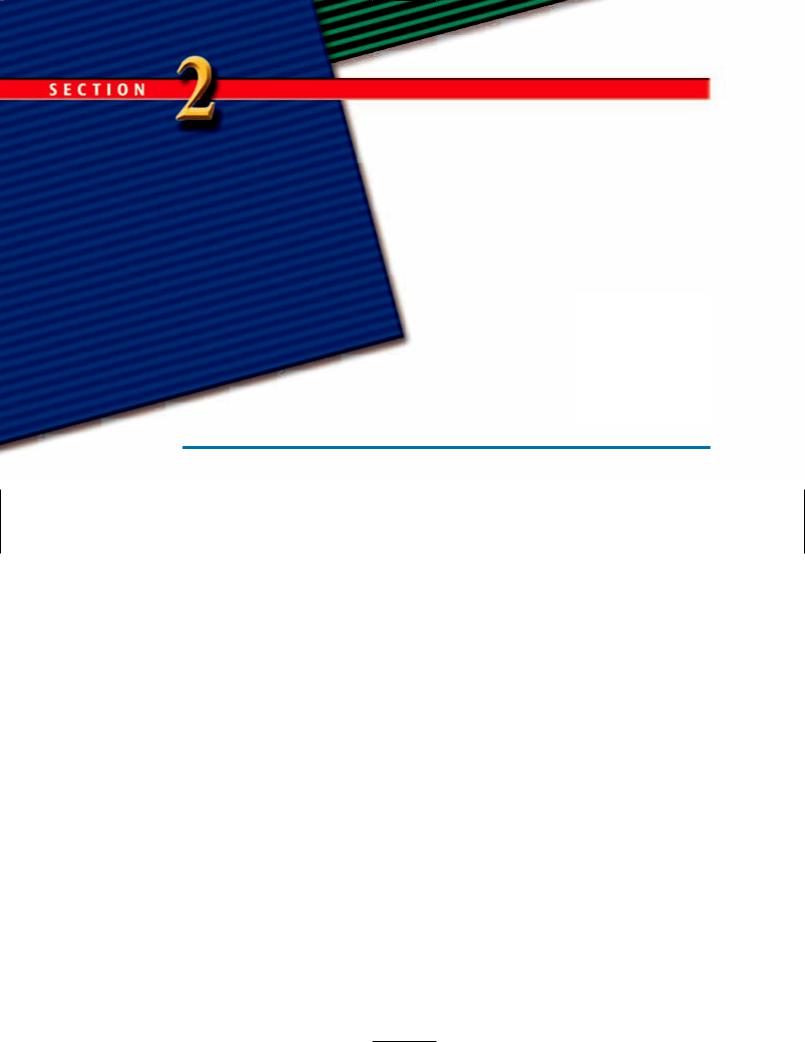
A Monopolistic
Market
Focus Questions
What are the characteristics of a monopolistic market?
What are examples of barriers to entry?
Do monopolists ever face competition?
What purpose do antitrust laws serve?
What have been some of the major antitrust laws?
Key Terms
monopolistic market barrier to entry price searcher public franchise natural monopoly antitrust law
monopolistic market
A market structure characterized by (1) a single seller, (2) the sale of a product that has no close substitutes, and
(3) extremely high barriers to entry.
barrier to entry
Anything that prohibits a firm from entering a market.
price searcher
A seller that can sell some of its output at various prices.
Characteristics of a
Monopoly
The three characteristics of a monopolistic market include the following:
1.The market consists of one seller.
2.The single seller sells a product that has no close substitutes.
3.The barriers to entry are high, which means that entry into the market is extremely difficult.
How Monopolists Differ from Perfect Competitors
Perfectly competitive firms are price takers. A monopoly firm (or monopolist) is a price searcher. In contrast with a price taker, a price searcher can sell some of its product at various prices (for example, at $12, $11, $10, $9, and so on). Whereas a price taker has to “take” one price—the equilibrium price—and sell its product at that price, the price searcher has a list of prices from which to choose. The price searcher “searches” for the best price, the
price that generates the greatest profit or, in some cases, the price that minimizes losses.
Which of the many possible prices is the best price? To answer this question, back up and consider the questions that the monopoly firm, like any firm, has to answer: (1) How much do we produce? (2) How much do we charge? The monopoly firm, like any firm, will produce that quantity of output at which marginal revenue equals marginal cost.
Now suppose that for a monopoly firm this quantity turns out to be 20,000 units. What is the best price to charge for each unit? The best price turns out to be the highest price at which all 20,000 units can be sold. If only 15,000 units of the 20,000 units are sold at a price of $14, then $14 is not the best price. But if at $13, all 20,000 units can be sold, then $13 is the best price. Again, the monopoly firm seeks to charge the best price possible, which is the highest price at which it can sell its entire output.
Here is the problem for the monopolist: It does not know what its best price is. So, it has to search for it through a process of trial and error. It may charge one price this week, only to change it next week. Over time, a
194 Chapter 8 Competition and Markets

How might the owner of this small, neighborhood store have a monopoly?
monopoly firm finds the highest price at which it can sell its entire output.
 Suppose you are taking a long drive along a route that has only one gas station. The sign reads: Last Chance for Gas for 100 Miles. Gasoline is a product with very few substitutes. You can’t put water in your gas tank and hope that the car will run. The gas station is a local monopolist; in other words, it’s not that it is the only gas station in the world, but it is the only gas station in a certain small part of the world. The gas station owner decided that the best quantity of gas for her to sell is 400 gallons. Now, of course, she wants to find the highest price per gallon at which she can sell all 400 gallons. She may have to “search” for this price. Is $2.76 too low? Is $3.18 too high? It is likely that through trial and error she will eventually figure out what the highest price is at which she can sell all 400 gallons of gas.
Suppose you are taking a long drive along a route that has only one gas station. The sign reads: Last Chance for Gas for 100 Miles. Gasoline is a product with very few substitutes. You can’t put water in your gas tank and hope that the car will run. The gas station is a local monopolist; in other words, it’s not that it is the only gas station in the world, but it is the only gas station in a certain small part of the world. The gas station owner decided that the best quantity of gas for her to sell is 400 gallons. Now, of course, she wants to find the highest price per gallon at which she can sell all 400 gallons. She may have to “search” for this price. Is $2.76 too low? Is $3.18 too high? It is likely that through trial and error she will eventually figure out what the highest price is at which she can sell all 400 gallons of gas.
QUESTION: You mentioned that the gas station is a local monopolist. I am interested in the word “local” here. Do you mean to imply that a seller might be a monopolist in one area but not in another?
ANSWER: Yes. Think of a small grocery store instead of a gas station. The small grocery store might be the only grocery
store in 10 square miles, but not the only grocery store in 20 square miles. Or think of a bookstore on a university campus. Many university campuses have only one bookstore that sells the textbooks that students buy. Some would consider the bookstore in this setting a monopolist. Of course, with the introduction of the Internet, this bookstore isn’t as much a monopolist today as it might have been in years gone by. Today, students can buy many of their textbooks online, either directly from the publisher or from an online bookstore.
How Selling Corn or Stock Differs from Selling Cable Television Service
Perhaps nothing brings home the difference between a perfectly competitive seller (a price taker) and a monopoly seller (a price searcher) than placing yourself in the role of each. First, suppose you are a corn farmer in Iowa. You just harvested 100,000 bushels of corn, and you want to sell them as quickly as possible. It’s easy to determine at what price you sell your corn: you just check the newspaper or listen to the crop report on the radio or TV news to see what price corn is selling at. That’s the price you take for your corn.
Now say you own a cable television company. In many towns only one cable company
Section 2 A Monopolistic Market 195
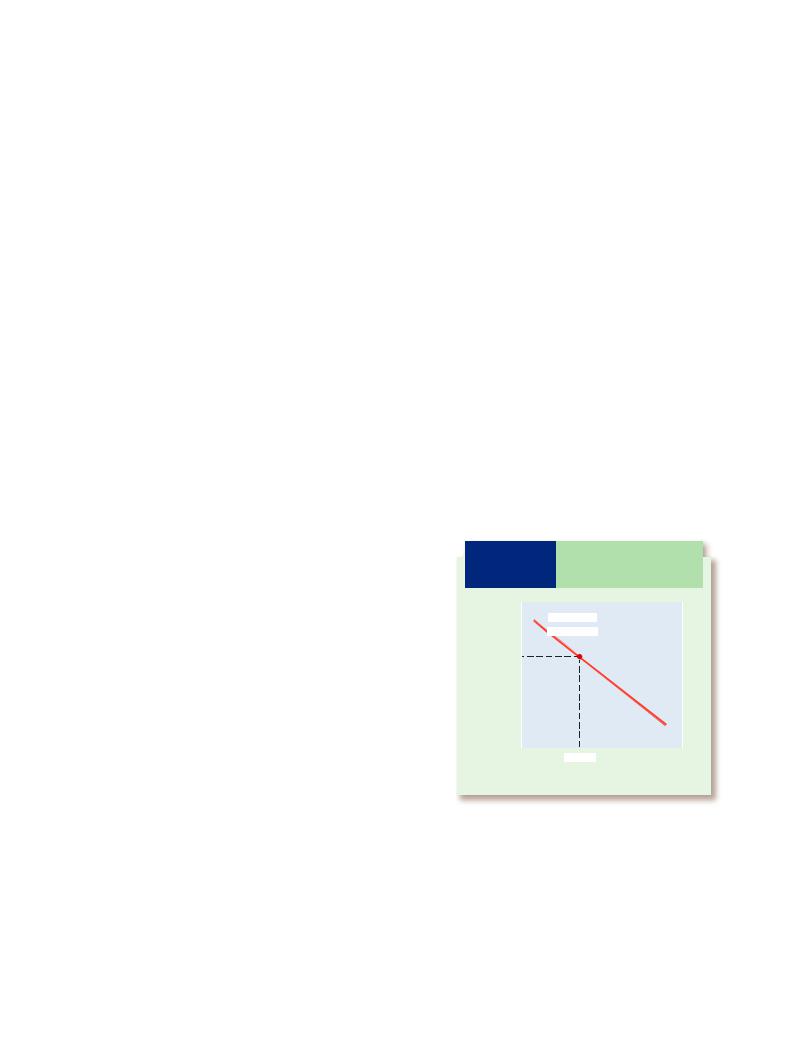
is allowed to serve a certain geographic area; therefore, you are a monopolist. (Although with satellite TV, the local cable company is probably less of a monopolist than it once was.) The cable wire has been laid across town, and you are ready for business. What do you charge for your cable service? The answer is not so easy this time. No “cable television report” provides the market with information the way a crop report does. Thus, even though it is rather easy for firms to determine their selling prices in perfectly competitive markets, price determination is not so easy in monopolistic markets.
Is the Sky the Limit for the Monopolist?
Suppose a pharmaceutical company recently invented a new medicine that cures arthritis. With respect to this medicine, the pharmaceutical company is a monopolist; it is the only seller of a medicine that has no close substitutes. Can the pharmaceutical company charge any price it wants for the medicine? For example, can it charge $5,000 for one bottle (24 pills) of medicine? If your answer is yes, ask yourself whether the company can charge $10,000 for one bottle. If your answer is still yes, ask yourself whether the company can charge $20,000 for one bottle.
The purpose of these questions is to get you to realize that monopolists do face a limit as to how high a price they can charge. The sky is not the limit. At some high prices in our example, no one, not even someone who suffers greatly from arthritis pain, is willing to buy the medicine.
The monopolist is limited by the “height” of the demand curve it faces. What do we mean by the “height” of the demand curve? Suppose the demand curve in Exhibit 8-1 is the demand curve for the medicine that cures arthritis and that the pharmaceutical company has decided to produce 500,000 bottles of medicine. As you can see, the highest price (per bottle) that can be charged for each bottle of 500,000 bottles is determined by the height of the demand curve, $100 per bottle. The sky is not the limit; the height of the demand curve (at the quantity of output the firm wants to sell) is the limit.
A Monopoly Seller Is Not
Guaranteed Profits
Most people think that if a firm is a monopoly seller, it is guaranteed to earn profits. This assumption is not true, however; no monopoly seller is guaranteed profits. A firm earns profits only if the price it sells its good for is above its average total cost. For example, if a firm sells its good for $10 and average total cost (per-unit cost) is $6, then it earns $4 profit per unit. If it sells 1,000 units, its profit is $4,000.
The monopolist sells its product for the highest price possible, but nothing guarantees that this price is greater than the monopoly seller’s average total cost. If it is not, the monopoly seller does not earn any profits. If average total cost for the monopoly seller is actually higher than the highest possible price for which it sells its product, the monopoly seller earns a loss (not a profit). If this situation continues, the monopoly seller will go out of business.
 Tony has gone into business; he sells a good that no one else sells.
Tony has gone into business; he sells a good that no one else sells.
E X H I B I T 8-1 Is the Sky the Limit for the Monopolist?
Demand for
medicine
$100 cei rP
0 500,000
Bottles of medicine
Once a monopoly firm decides on its quantity of output, it is limited to the highest price it can charge (per unit) for the product.
Specifically, it is limited by the height of the demand curve. In this case the monopoly firm decides to produce 500,000 bottles of medicine. The highest price it can charge (per unit) and sell this output is $100 per bottle.
196 Chapter 8 Competition and Markets
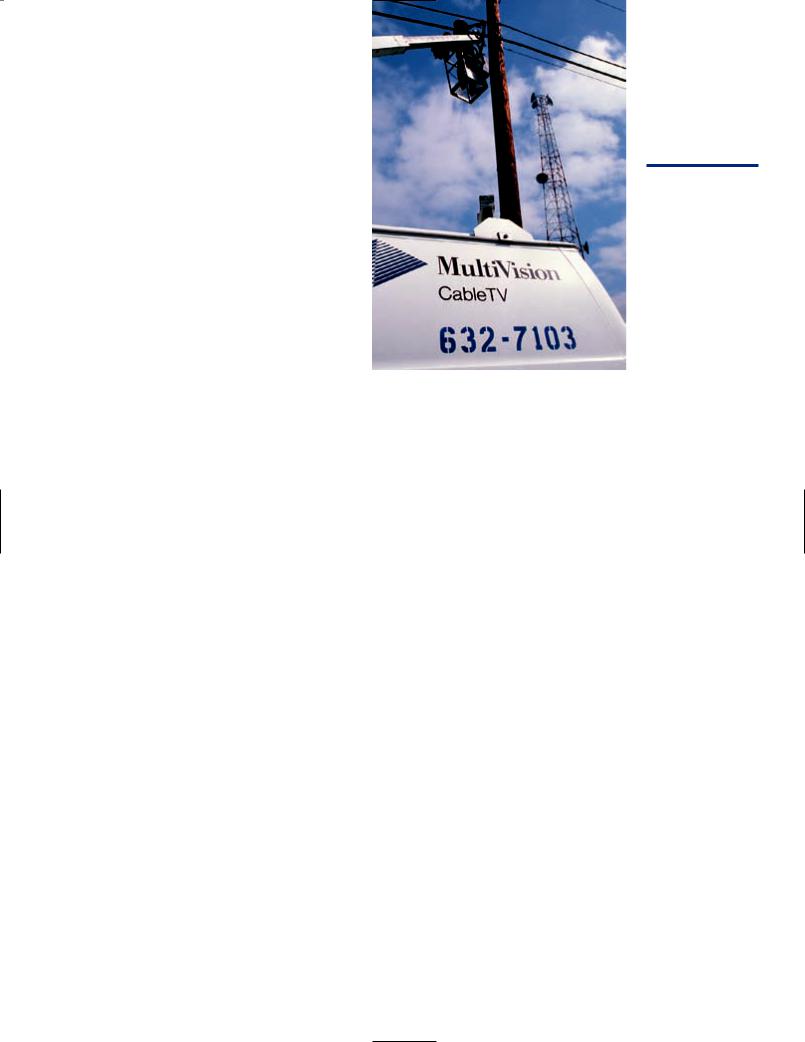
Because he is the only one who sells this particular good, his friend refers to him as a monopolist. Is Tony guaranteed profit because he is the only seller of a particular good? Not necessarily. It turns out that no one demands the good that Tony sells. In other words, a seller could possibly be a monopolist and not sell anything. The objective many sellers set for themselves is to be a monopolist with respect to a good for which demand is high.
Barriers to Entry
Suppose firm X is a monopolist. It is currently charging a relatively high price for its product and earning large profits. Why don’t other businesses enter the market and produce the same product as firm X? As noted earlier, one of the three characteristics of a monopolistic market is high barriers to entry. They include legal barriers, a monopolist’s extremely low average total costs, and a monopolist’s exclusive ownership of a scarce resource.
Legal Barriers
Legal barriers to entry in a monopoly market include public franchises, patents, and copyrights. A public franchise is a right granted to a firm by government that permits the firm to provide a particular good or service and excludes all others from doing so. Potential competition is thus eliminated by law.
For example, as stated earlier, in many towns only one cable company is allowed to service a particular geographic area. This company has been given the exclusive right to produce and sell cable television. If an organization other than the designated company were to start producing and selling cable television, it would be breaking the law.
Another example of a legal barrier is the restriction the U.S. government has placed on private mail carriers. Only the U.S. Postal Service can deliver first-class mail. Also, some towns make it illegal for more than one company to collect trash.
In the United States, a patent is granted to the inventor of a product or process for 20 years. For example, a pharmaceutical com-
pany may have a patent on a medicine. During this time, the patent holder is shielded from competitors; no one else can legally produce and sell the patented product or process.
Copyrights give authors or originators of literary or artistic productions the right to publish, print, or sell their intellectual productions for a period of time. With books, either the author or the company that publishes the book holds the copyright. For example, the publishing company holds the copyright to this textbook—it owns the right to reproduce and sell copies of this book. Anyone else who copies the book or large sections of it to sell or simply to avoid buying a copy is breaking the law.
Extremely Low Average Total Costs
(Low Per-Unit Costs)
Chapter 7 described average total cost as total cost divided by quantity of output, also called per-unit cost. For example, if total cost is $1,000 and quantity of output is 1,000 units, then average total cost is $1 per unit.
In some industries, firms have an average total cost that is extremely low—so low that no other firm can compete with this firm. To see why, let’s consider the relationship of average total cost and price. A business will earn a per-unit profit when it sells its product for a price that is higher than its average total cost. For example, if price is
A cable TV company may have a monopoly in a certain geographic area.
Are there any barriers to entry here?
public franchise
A right granted to a firm by government that permits the firm to provide a particular good or service and excludes all others from doing so.
Section 2 A Monopolistic Market 197
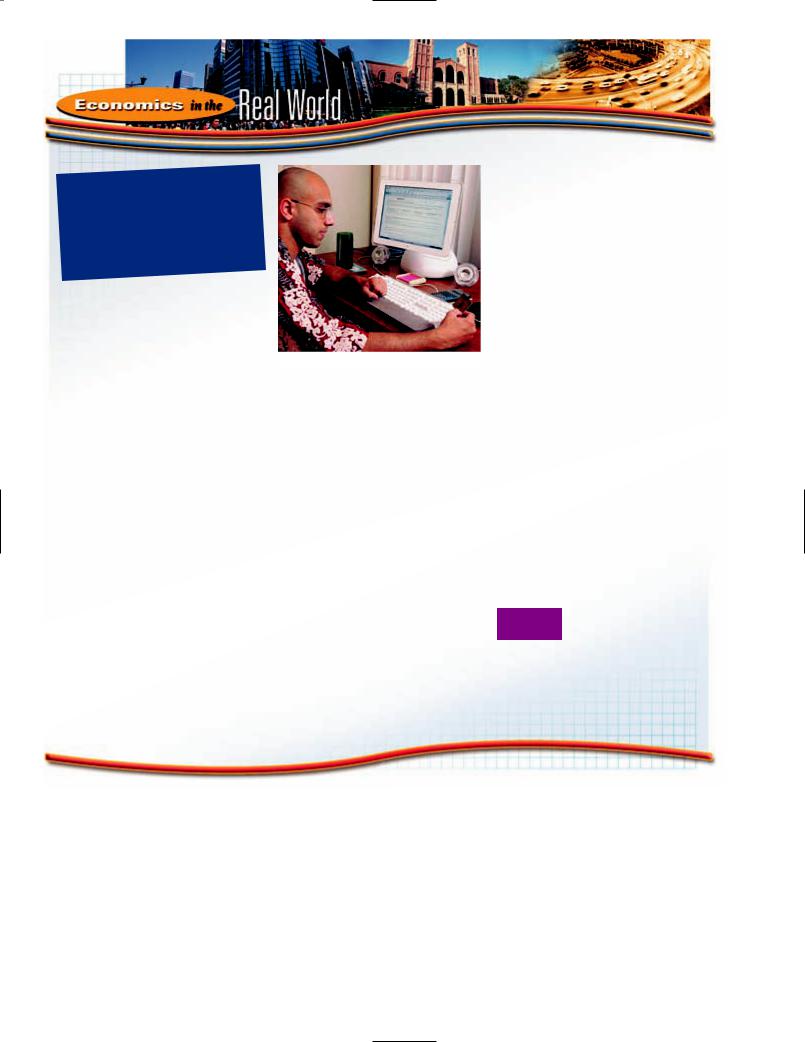
Willthe |
||
??? |
||
Internet |
Bring |
|
an |
Endto |
|
|
|
|
Monopolies? |
||
Many college campuses have only one bookstore.
Professors tell the campus bookstore manager the books they want their students to buy, and the bookstore orders the books. During the first weeks of classes, students usually go to the bookstore and buy the books they need. They often complain about the high price of textbooks; it is not uncommon for textbooks to sell for $100 or more.
Many college students feel that to a large degree, the campus bookstore acts as a monopolist. It is a single seller of a good (required textbooks) that has no substitutes (the student has to buy the book the professor is using in class, not a book that is similar). Usually the university administration will not allow more than one bookstore on campus (so barriers to entry are high). In a way, we might consider the campus bookstore a local or
geographic monopoly: it is the single seller of a good with no good substitutes and high barriers to entry in a certain location—the university campus.
Enter the Internet, which has, to a large degree, destroyed many local or geographic monopolies. College students no longer have to buy their textbooks from their campus bookstore. They can buy them from an online bookstore such as Amazon.com, which often discounts the books it sells. In other words, the Internet essentially eliminates the barrier to entering any campus’s textbook market.
Similarly, some people think that the Internet eliminates local monopolies in cars, although the case is less strong here. Suppose you live
in a town with only one Ford dealership. It is true that the dealership may be the sole seller of Fords within a certain area (say, a radius of 40 miles), but substitutes for a Ford (for example, a Honda) are available. Nevertheless, it is possible for a single Ford dealership to have a certain degree of monopoly power. If you want a Ford, you
are inclined to go to that Ford dealership.
Again, the Internet changes that situation. First, at various online sites you can obtain the invoice price of any car you are thinking about buying. Second, you can contact Ford dealers in nearby areas via the Internet and ask them if they are willing to sell you a Ford for, say, $1,500 over invoice price. Now, instead of negotiating with the only Ford dealership in town, you can negotiate with several dealerships over the Internet.
The Internet is used to weaken local (or geo-
graphic) monopolies in textbooks and cars. Can you identify any other kinds of local monopolies threatened by the Internet?
natural monopoly
A firm with such a low average total cost (perunit cost) that only it can survive in the market.
$10 and average total cost is $4, then perunit profit is $6.
Some companies may have such a low average total cost that they are able to lower their prices to a very low level and still earn profits. Consequently, competitors may be forced out of business. Suppose 17 companies are currently competing to sell a good. One of the companies, however, has a much
lower average total cost than the others. Say company A’s average total cost is $5, whereas the other companies’ average total cost is $8. Company A can sell its good for $6 and earn a $1 profit on each unit sold. Other companies cannot compete with it. In the end, company A, because of its low average total cost, is the only seller of the good; such a firm is called a natural monopoly.
198 Chapter 8 Competition and Markets
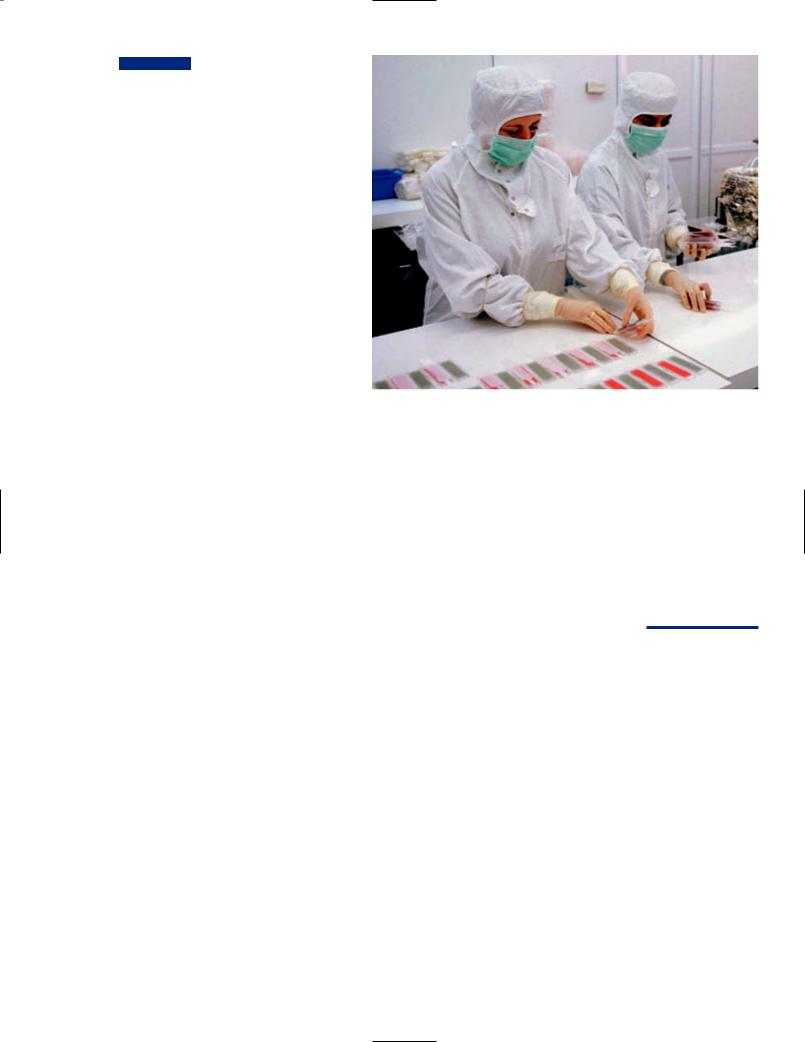
Three companies, A, B, and C, all sell a particular good. The perunit costs of company A are $4 while the per-unit costs for B and C are $7. Currently, all three companies sell their good for a price of $10. In time, company A lowers its price to $6, but companies B and C cannot follow suit. For them to lower price to $6 would mean they would incur a $1 perunit loss on each item they produce and sell. Because of its lower price, customers start buying from company A instead of from B and C. In time, companies B and C go out of business.
Exclusive Ownership of a Scarce
Resource
It takes oranges to produce orange juice. Suppose one firm owned all the oranges; it would be considered a monopoly firm. The classic example of a monopolist that controls a resource is the Aluminum Company of America (Alcoa). For a long time, this company controlled almost all sources of bauxite (the main source of aluminum) in the United States, making Alcoa the sole producer of aluminum in the country from the late nineteenth century until the 1940s.
Government Monopoly and Market
Monopoly
Sometimes high barriers to entry exist because competition is legally prohibited, and sometimes they exist for other reasons. Where high barriers take the form of public franchises, patents, or copyrights, competition is legally prohibited. In contrast, where high barriers take the form of one firm’s low average total cost or exclusive ownership of a resource, competition is not legally prohibited. In these cases, no law keeps rival firms from entering the market and competing, even though they may choose not to do so.
Some economists use the term government monopoly to refer to monopolies that are legally protected from competition. They use the term market monopoly to refer to monopolies that are not legally protected from competition.
Antitrust and Monopoly
One of the stated objectives of government is to encourage competition so that monopolists do not have substantial control over the prices they charge. Let’s look briefly at some of the issues involved in maintaining competition.
Antitrust Laws
The government tries to meet its objectives through its antitrust laws, laws meant to control monopoly power and to preserve and promote competition. Following are descriptions of some of the major antitrust laws. Exhibit 8-2 provides a quick look at a time line for the implementation of these laws.
The Sherman Antitrust Act The Sherman Antitrust Act (or, simply, the Sherman Act) was passed in 1890, a time when there were numerous mergers between companies. A merger occurs when one company buys more than half the stock in another company, putting two companies under one top management. At the time of the Sherman Act, the organization that two companies formed by combining to act as a monopolist was called a trust, which in turn gave us the word antitrust.
Research companies often obtain patents on their products, which prevent other companies from entering the market for a specified time period. Do you think such barriers to entry are necessary? Explain.
antitrust law
Legislation passed for the stated purpose of controlling monopoly power and preserving and promoting competition.
Section 2 A Monopolistic Market 199
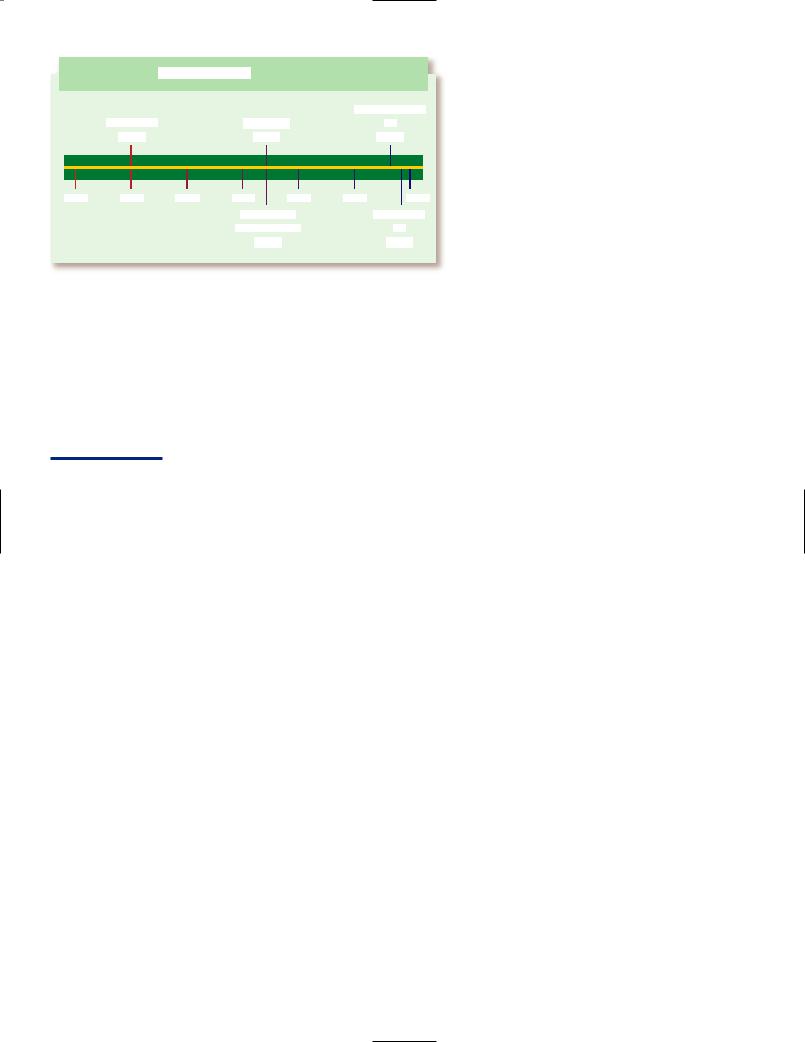
|
E X H I B I T 8-2 |
|
|
|
|
|
|
|
|
|
|
|
|
|
|
|
|
|
|
|
|
|
|
|
|
|
|
|
|
|
|
|
|
|
|
|
|||||||
Antitrust Acts |
|
|
|
|
|
|
|
|
|
|
|
|
|
|
|
|
|
|
|
|
|
|
|||||||||||||||||||||
|
|
|
|
|
|
|
|
|
|
|
|
|
|
|
|
|
|
|
|
|
|
|
|
|
|
|
|
|
|
|
|
|
|
|
|
|
|
|
|
|
|
|
|
|
|
|
|
|
|
|
|
|
|
|
|
|
|
|
|
|
|
|
|
|
|
|
|
|
|
|
|
|
|
|
|
|
|
|
|
|
|
||||||
|
|
|
|
|
|
|
|
|
|
|
|
|
|
|
|
|
|
|
|
|
|
|
|
|
|
|
|
Robinson-Patman |
|||||||||||||||
|
|
|
|
|
|
|
|
|
|
|
|
|
|
|
|
|
|
|
|
|
|
|
|
|
|
|
|
|
|
|
|
|
|
|
|
|
|
||||||
|
|
|
Sherman Act |
Clayton Act |
|
|
|
||||||||||||||||||||||||||||||||||||
|
|
|
|
|
|
|
|
|
|
|
|
|
|
|
|
|
|
|
Act |
||||||||||||||||||||||||
|
|
|
|
|
|
|
|
|
|
|
|
|
|
|
|
|
|
|
|
|
|
|
|
|
|
|
|
|
|
|
|
|
|
|
|
|
|||||||
|
|
|
(1890) |
|
|
|
|
|
(1914) |
|
|
|
|
|
|
|
|
|
(1936) |
||||||||||||||||||||||||
|
|
|
|
|
|
|
|
|
|
|
|
|
|
|
|
|
|
|
|
||||||||||||||||||||||||
|
|
|
|
|
|
|
|
|
|
|
|
|
|
|
|
|
|
|
|
|
|
|
|
|
|
|
|
|
|
|
|
|
|||||||||||
1880 |
1890 |
1900 |
1910 |
|
1920 |
1930 |
1940 |
||||||||||||||||||||||||||||||||||||
|
|
|
|
|
|
|
|
|
|
|
|
|
|
|
|
|
|
|
|
|
|
|
|
|
|
|
|
|
|
|
|
|
|
|
|
|
|
|
|
|
|
|
|
|
|
|
|
|
|
|
|
|
|
|
|
|
Federal Trade |
|
|
|
Wheeler-Lea |
||||||||||||||||||||||||||
|
|
|
|
|
|
|
|
|
|
|
|
|
|
|
|
|
|
|
|
|
|
|
|
|
|
|
|
|
|
|
|
|
|
|
|||||||||
|
|
|
|
|
|
|
|
|
|
|
|
|
|
Commission Act |
|
|
|
||||||||||||||||||||||||||
|
|
|
|
|
|
|
|
|
|
|
|
|
|
|
|
|
|
|
|
|
|
|
Act |
||||||||||||||||||||
|
|
|
|
|
|
|
|
|
|
|
|
|
|
|
|
|
|
|
|
|
|
|
|
|
|
|
|
|
|
|
|
|
|
|
|
||||||||
|
|
|
|
|
|
|
|
|
|
|
|
|
(1914) |
|
|
|
|
|
|
|
|
|
(1938) |
||||||||||||||||||||
Major antitrust acts in U.S. history include the Sherman Act, the Clayton Act, the Federal Trade Commission Act, the Robinson-Patman Act, and the Wheeler-Lea Act.
The Sherman Act contains two major provisions:
1.“Every contract, combination in the form of trust or otherwise, or conspiracy, in restraint of trade or commerce . . .
is hereby declared to be illegal.”
2.“Every person who shall monopolize, or attempt to monopolize, or combine or conspire with any other person or persons to monopolize any part of the trade or commerce . . . shall be deemed guilty of a misdemeanor.”
Together, these two provisions state that either attempting to become a monopolist or trying to restrain trade is illegal.
The Clayton Act The Clayton Act of 1914 made certain business practices illegal when their effects “may be to substantially lessen competition or tend to create a monopoly.” Here are two practices that were prohibited by the act:
1.Price discrimination. Price discrimination occurs when a seller charges different buyers different prices for the same product and when the price differences are not related to cost differences. For example, if a company charges you $10 for a product and charges your friend $6 for the same product, and there is no cost difference for the company in providing the two of you with this product, then the company is practicing price discrimination. (You will learn more about price discrimination near the end of the chapter.)
2.Tying contracts. A tying contract is an arrangement whereby the sale of one
product depends on the purchase of some other product or products. For example, suppose the owner of a company that sells personal computers and computer supplies agrees to sell computers to a store only if the store owner agrees to buy paper, desk furniture, and some other products, too. This agreement is a tying contract, and it is illegal under the Clayton Act.
The Federal Trade Commission Act The Federal Trade Commission Act, passed in 1914, declared that “unfair methods of competition in commerce” were illegal. In particular, the act was designed to prohibit aggressive price-cutting acts, sometimes referred to as cutthroat pricing.
 Suppose you own a business that produces and sells tires. A competitor begins to drastically lower the prices of the tires it sells. From your viewpoint, your competitor may be engaged in cutthroat pricing. From the viewpoint of the consumer, your competitor is simply offering a good deal. The FTC officials, who enforce the Federal Trade Commission Act, will have to decide. If they believe your competitor is cutting its prices so low that you will have to go out of business and that it intends to raise its prices later, when you’re gone, they may decide that your competitor is violating the act.
Suppose you own a business that produces and sells tires. A competitor begins to drastically lower the prices of the tires it sells. From your viewpoint, your competitor may be engaged in cutthroat pricing. From the viewpoint of the consumer, your competitor is simply offering a good deal. The FTC officials, who enforce the Federal Trade Commission Act, will have to decide. If they believe your competitor is cutting its prices so low that you will have to go out of business and that it intends to raise its prices later, when you’re gone, they may decide that your competitor is violating the act.
Some economists have noted that the Federal Trade Commission Act, like other antitrust acts, contains vague terms. For instance, the act does not precisely define what “unfair methods of competition” consist of. Suppose a hotel chain puts up a big, beautiful hotel across the street from an old, tiny, run-down motel, and the old motel ends up going out of business. Was the hotel chain employing “unfair methods of competition” or not?
The Robinson-Patman Act The RobinsonPatman Act was passed in 1936 in an attempt to decrease the failure rate of small businesses by protecting them from the competition of large and growing chain stores. At that time in our economic history, large chain stores had just arrived on the scene.
200 Chapter 8 Competition and Markets

Copies of Judge Thomas Penfield Jackson’s ruling against Microsoft in November of 1999 were in high demand. The case was one of the major antitrust cases of the twentieth century. What would a company have
to do to be guilty of antitrust violations?
They were buying goods in large amounts and were sometimes being offered price discounts from their suppliers. The chain stores began to pass on the price discounts to their customers. The small businesses were not being offered the price discounts and thus found it increasingly difficult to compete with the chain stores. The Robinson-Patman Act prohibited suppliers from offering special discounts to large chains unless they also offered the discounts to everyone else.
Many economists believe that rather than preserving and strengthening competition, the Robinson-Patman Act limited it. The act, they say, seemed more concerned about a particular group of competitors (small businesses) than about the process of competition.
The Wheeler-Lea Act The Wheeler-Lea Act, passed in 1938, empowered the Federal Trade Commission (FTC), a government agency, to deal with false and deceptive acts or practices by businesses. Major actions by the FTC in this area have involved advertising that the agency has deemed false and deceptive.
The Issue of Natural Monopoly
Instead of applying antitrust laws to natural monopoly, often what government does is impose some kind of regulation on the natural monopolist. For example, instead of allowing the natural monopoly to charge
any price it wants, government often sets the price that the natural monopoly can charge. Alternatively, sometimes government specifies a certain rate of profit the natural monopoly can earn.
There are often unintended effects of government regulation of natural monopolists. For example, suppose government states that the natural monopolist can only charge a price of $2 above costs. If the natural monopolist knows that it can always charge a price of $2 higher than costs, it will have little, if any, incentive to keep its costs down. In the end, consumers may end up paying high prices because the natural monopolist knows that no matter what its costs are, it can always charge a price $2 higher (than costs). Similarly, if a natural monopoly is guaranteed a certain rate of profit, it will have little incentive to hold down its costs.
Are Antitrust Laws Always
Applied Properly?
People are inclined, perhaps, to believe that when the government enforces the antitrust laws, it does so properly. Government may be seen as riding into the market on a white horse, preventing monopolies from running roughshod over consumers. In reality, the record of government in this area is mixed. Sometimes government,
Section 2 A Monopolistic Market 201
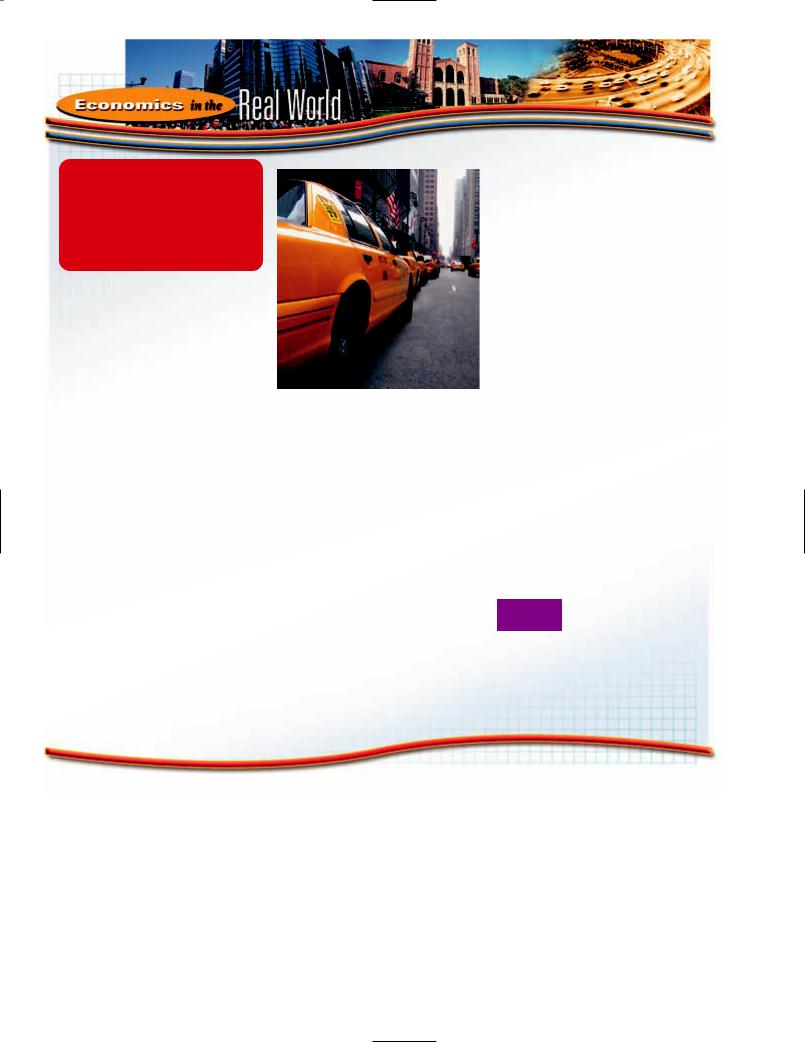
Why So Much for Such a Short Ride?
??????????????????
It is easy for new firms to enter some markets and difficult for them to enter others. Difficulty in
entering a market is usually caused by the existence of some barrier to entry. Of course, not all barriers to entry are the same. One kind is created through legal means. For example, when the government specified that no firm can compete with the U.S. Postal Service in the delivery of first-class mail, it effectively created a legal barrier to entering the business of delivering first-class mail.
Suppose you go to New York City. You visit Rockefeller Center and Madison Square Garden; you take a tour of the Empire State Building and the Statue of Liberty; you go to a Broadway play at night. In your travels around New York City, you notice taxicabs picking up and delivering people. You wonder what you or anyone else would need to do to enter the taxicab market in New York City.
Let’s list the things that sound reasonable. You would need a car and a driver’s license. Perhaps the city of New York would want to make sure that you did not have a criminal record, so you might need to pass a personal background check.
In reality, the Taxi and Limousine Commission in New York City requires that you also have a taxi license, called a taxi medallion. It is similar to a business license: you need it to lawfully operate a taxicab business in New York City. In 2003 the price of a taxi medallion was $220,214.
The high price of a taxi medallion acts as a barrier to entering the
taxicab market in New York City. Who gains and who loses as a result of this barrier to entry? The beneficiaries are clearly the current owners of taxicab businesses. Because of such a high barrier to entering the taxicab business, the supply of taxis on the streets of New York City is less than it otherwise would be. If supply is lower than it would be, then prices are higher. In other words, the price of a taxi ride in New York City is likely to be less if a taxi medallion cost, say, $300 than if it cost $220,000. At the latter price, fewer people will be entering the taxicab business and expanding the supply of taxis for hire. The losers are (1) people who would like to enter the taxicab business but cannot and (2) the taxi riders who pay higher prices because of the somewhat restricted entry into the taxicab business.
THINK |
As a result of the high |
ABOUT IT |
price of a taxi medal- |
|
lion, taxi fares are higher than they would be if taxi medallion prices were lower. Do you agree or disagree?
through its enforcement of the antitrust laws, promotes and protects competition, and sometimes it does not.
 In 1967, the Salt Lake City–based Utah Pie Company charged that three of its competitors in Los Angeles were practicing price discrimination, which is deemed illegal by the Clayton Act. Specifically,
In 1967, the Salt Lake City–based Utah Pie Company charged that three of its competitors in Los Angeles were practicing price discrimination, which is deemed illegal by the Clayton Act. Specifically,
the three competitors were charged with selling pies in Salt Lake City for lower prices than they were selling them near their plants of operation. The U.S. Supreme Court ruled in favor of Utah Pie.
What were the facts? Were the three competitors from Los Angeles running Utah Pie out of business? Were they hurting consumers by charging low prices? Some econ-
202 Chapter 8 Competition and Markets

omists have noted that Utah Pie actually charged lower prices for its pies than did its competitors and that it continued to increase its sales volume and earn a profit during the time its competitors were supposedly exhibiting anticompetitive behavior. These economists suggest that Utah Pie was simply trying to use the antitrust laws to hinder its competition.
Now consider a case in which most economists believe that the antitrust laws were applied properly. For many years, the upperlevel administrators of some of the top universities—Brown, Columbia, Cornell, Dartmouth, Harvard, MIT, Princeton, University of Pennsylvania, and Yale—met to discuss such things as tuition, faculty salaries, and financial aid. There seemed to be evidence that these meetings occurred because the universities were trying to align tuition, faculty raises, and financial need. For example, one of the universities wanted to raise faculty salaries by more than the others but was persuaded not to do so. Also at these meetings, the administrators would compare lists of applicants to find the names of students who had applied to more than one of their schools (for example, someone might have applied to Harvard,Yale, and MIT). The administrators would then adjust their finan-
Richard Branson, CEO of Virgin Atlantic Airlines, testifies against an airline industry merger before a Senate subcommittee on antitrust in 2001.
The U.S. Justice Department charged the universities with a conspiracy to fix prices. Eight of the universities settled the case by agreeing to cease colluding (making secret agreements that effectively reduce competition) on tuition, salaries, and financial aid. MIT pursued the case to the U.S. Supreme Court. In 1992, the Supreme Court ruled
Defining Terms
1.Define:
a.barrier to entry
b.natural monopoly
c.price searcher
d.antitrust law
Reviewing Facts and
Concepts
2.When it comes to determining the quantity of goods to produce, how is a monopolist like a perfect competitor?
3.A monopolist is a price searcher. For what price is
the monopolist searching?
4.A company advertises its product in a deceptive manner. Which antitrust act would apply to this action?
Critical Thinking
5.Firm A is a perfectly competitive firm, and firm B is a monopoly firm. Both firms are currently earning profits. Which firm is less likely to be earning
profits in the future? Explain your answer.
Applying Economic
Concepts
6.The demand for the good that firm A sells does not rise or fall during the month. Firm A raises its price at the beginning of the month and lowers its price at the end of the month. What might explain firm A’s pricing behavior?
Section 2 A Monopolistic Market 203
